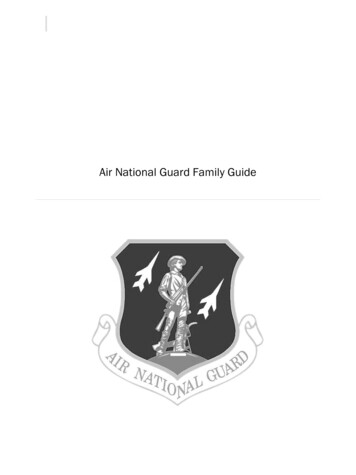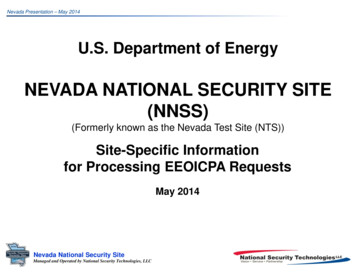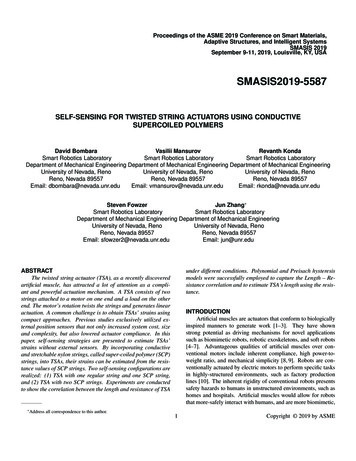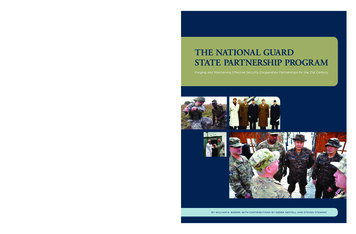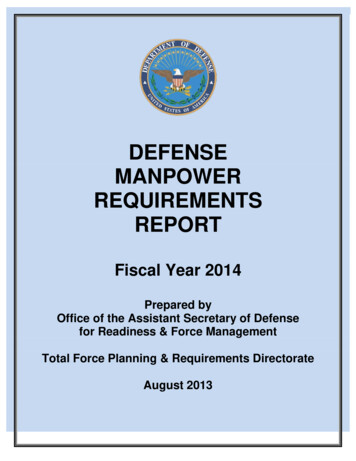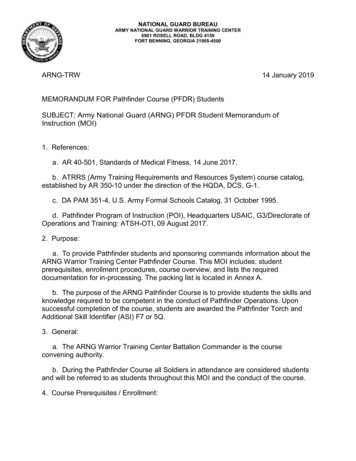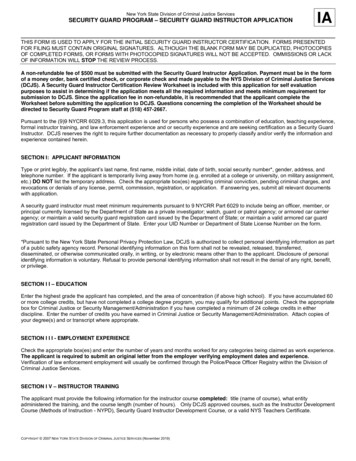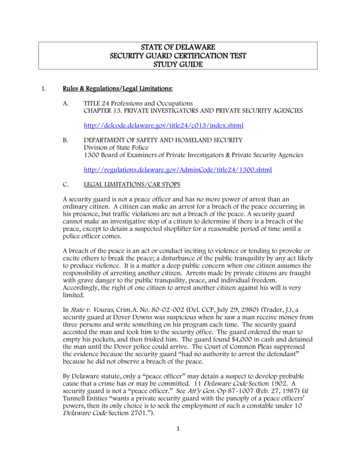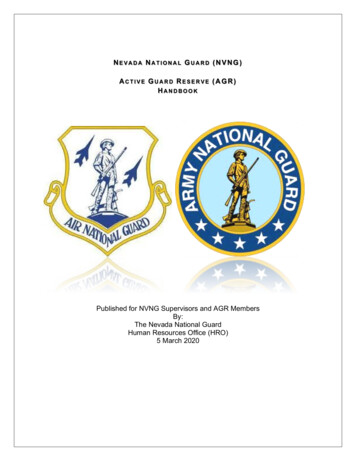
Transcription
NEVADA NATIONAL GUARD (NVNG)ACTIVE GUARD RESERVE (AGR)HANDBOOKPublished for NVNG Supervisors and AGR MembersBy:The Nevada National GuardHuman Resources Office (HRO)5 March 2020
NVNG AGR HandbookMESSAGE FROM THE ADJUTANT GENERAL Congratulations on being selected as a member in the Active Guard/Reserve Program.You can take great pride in your selection to serve in this important role contributing tothe unit readiness and combat capability of the Nevada National Guard.The Human Resources Office (HRO) is pleased to provide the NVNG AGR Handbook toall managers, supervisors, and AGR members of the Nevada National Guard to assistyou in accomplishing this mission.ABOUT THE HANDBOOKThis handbook serves as a guide to assist commanders, supervisors, ActiveGuard/Reserve (AGR) members, and dependents in becoming familiar with the AGRProgram of the Nevada National Guard. It is a consolidated source of information and isintended to provide an overview of the AGR program. The guidance has been draftedbased on Army, Air, and Federal statutes and regulations, as well as DoD, local andNational Guard Bureau policy.HOW TO USE THIS HANDBOOKThe content of the handbook covers topics of interest in a sequence developed to educateemployees about the AGR program and assist supervisors with the steps involved inmanaging the AGR workforce.The accomplishment of our mission and vision are realized when we understand andsupport each other’s needs and the vast diversity of our workforce. To this end, the NVNGAGR Handbook is provided to you./////////////////ORIGINAL SIGNED///////////////////////ONDRA BERRY, Brig Gen, USAFThe Adjutant General, NVMD1
ContentsNVNG AGR HandbookSection 1 – General Information . 51-1: Overview of AGR Program . 51-2: Identification Cards . 51-3: Duty Hours. 61-4: Workplace Searches. 71-5: Inspector General (IG) . 71-6: Violence in the Workplace . 81-7: Privately Owned Firearms . 81-8: Tobacco Use in Government Facilities . 81-9: Access to Military Installations . 91-10: Diversity and Inclusion / Equal Opportunity (EO) . 91-11: SHARP / SAPR . 10Section 2 – Standards of Performance and Conduct . 102-1: Dress and Appearance. 102-2: Physical Fitness Program . 112-3: Army Body Composition Program . 122-4: Military Driver’s License . 122-5: Substance Abuse . 122-6: Sexual Assault and Sexual Harassment . 132-7: Membership in Extremist Groups . 142-8: Army Family Care Plans . 142-9: Fraternization and Professional Relationships . 152-10: Solicitation of Subordinates . 162-11: Gambling and Lotteries . 162-12: Gifts . 162-13: Computer Network Accounts / Systems Access . 172-14: Security Clearances . 172-15: Freedom of Information Act/Privacy Act . 182-16: Government Issued Credit Cards . 192-17: Assisting Recruiting & Retention Efforts . 192-18: Supply Accountability . 192-19: Off-Duty Employment . 201
NVNG AGR Handbook2-20: Unions . 202-21: Political Activities/Voting . 212-22: Jury Duty . 212-23: Lawsuits involving AGR Personnel . 222-24: Illegal Tape Recordings . 232-25: State Active Duty. 232-26: Absent Without Leave (AWOL). 23Section 3 – Career Lifecycle Management . 233-1: General Overview. 233-2: Entry into the AGR Program . 243-2a: Entry into the Air AGR Program . 243-2b: Entry into the Army AGR Program . 243-3: Length of Tour/Period . 253-4: In-processing and Orientation . 253-5: Performance Evaluations . 253-6: Career Management Program . 263-7: Priority Placement Program (PPP) . 263-8: Lateral Reassignment/Transfer. 263-8a: Air AGR Lateral Reassignment/Transfer. 273-8b: Army AGR Lateral Reassignment/Transfer . 273-9: Temporary AGR Fills (ANG) . 283-10: Controlled Grades . 293-11: Officer and Warrant Officer Promotions . 293-12: Enlisted Promotion System (EPS). 293-12a: Army National Guard Enlisted Promotion System . 293-13: Mandatory Professional Military Education. 293-14: Command Leadership and Staff Assignment Policy (CLASP) . 303-15: Mobilization . 313-16: Tour Continuation and Active Service Management Boards (ASMB) . 313-16b: Army Tour Continuation and Active Service Management Boards . 323-17: Release from AGR Program . 323-18: Types of Separations (Voluntary and Involuntary) . 333-19: Medical Separation . 333-20: Mandatory Separation . 332
NVNG AGR Handbook3-21: Retirement . 343-21a: Air National Guard AGR Retirement . 353-21b: Army National Guard AGR Retirement . 353-22: Out-Processing Procedures . 36Section 4 – Pay and Benefits . 364-1: Pay Process / Direct Deposit / Pay Inquiries . 364-2: Pay, Entitlements, Allowances and Special Incentive Pay . 374-3: Clothing Issue/Allowance . 384-4: Allotments . 384-5: Garnishment of Pay / Collection of Debts to the Government . 394-6: Permanent Change of Station (PCS) . 404-7: Unemployment Compensation . 414-8: Travel Pay / CLASP AGR Travel Entitlements . 414-9: Separation Pay / Severance Pay Leave . 424-10: Leave Administration / Chargeable Leave / Leave Accrual . 424-10a: Air National Guard Leave Administration / Chargeable Leave / LeaveAccrual . 434-10b: Army National Guard Leave Administration / Chargeable Leave / LeaveAccrual . 434-11: Maternity/Paternity Leave / Adoption Leave . 434-12: Convalescent Leave . 444-13: Passes . 454-14: Temporary Duty (TDY) and Permissive TDY . 464-15: Transition Leave . 46Medical and Dental Care . 464-16: Defense Enrollment Eligibility Reporting System (DEERS) . 464-17: TRICARE (Prime / Prime Remote / Standard / Extra) . 474-18: Active Duty Dental Program (ADDP) . 474-19: TRICARE Dental Program (TDP) . 484-20: Mental Health Evaluations for AGR Personnel . 484-21: Routine/Non-Emergency Care . 484-22: Emergency Care . 494-23: Civilian Hospitalization . 494-24: Military Treatment Facilities (MTF). 494-25: Prescriptions . 493
NVNG AGR Handbook4-26: Profiles . 50Other. 504-27: Life Insurance and Dependent Indemnity Compensation (DIC) . 504-28: Legal Assistance . 514-29: Employee Assistance Program (EAP) . 514-30: Thrift Savings Plan (TSP) . 524-31: Morale, Welfare and Recreation (MWR) . 534-32: Tuition Assistance (TA) . 534-33: GI Bill Benefits . 544-34: Survivor Benefit Plan (SBP) . 544-35: Space Available Flights (Space-A). 54Section 5 – Awards and Discipline . 555-1: Federal Awards . 555-2: State Awards . 555-3: Military Justice . 555-4: Counseling, Admonishment, and Reprimand . 565-5: Non-Judicial Punishment (Article 15) . 565-6: Administrative Discharge . 575-7: Court Martial. 575-8: Restraint/Confinement . 585-9: Arrest by Civilian Authorities . 58Appendices. 59A- Terms & Acronyms . 59B- Veterans Benefits . 59C- Points of Contact (POC) . 59D- Commonly Used Pay Documents . 60E- How to read an LES. 614
NVNG AGR HandbookSection 1 – General Information1-1: Overview of AGR ProgramThe Nevada National Guard (NVNG) Active Guard Reserve (AGR) Handbook providesinformation to help AGR personnel and their supervisors understand the NVNG AGRprogram, the rules governing the management of AGR personnel, and the variousentitlements and benefits that accrue to AGR personnel. It serves as a comprehensivesource of information, AGR personnel and their supervisors should use this handbookas the “first stop.” The NVNG AGR handbook, referred hereafter as the handbook,provides essential information in an easy to understand language in areas of concern.The information contained within this handbook will answer the great majority ofquestions using legal and regulatory references. Points of contact within the HumanResource Office (HRO) is located on Guard Knowledge Online (GKO) ff/j1/SitePages/Home.aspxIn the early 1980’s the National Guard established the AGR program with the purposeof providing a full-time military asset to improve readiness. AGR personnel provideskills, expertise, stability, and continuity to various National Guard units. Although onfull-time National Guard duty, AGR personnel differ from active duty military personnelin that they are under the command and control of the Governor rather than the Armyand Air Force directly. While AGR personnel have nearly the same pay allowances,benefits and privileges of active duty personnel, they are in state status (Title 32) astraditional Guard members and held to the same statutes and regulations as traditionalGuard members to include the Nevada Code of Military Justice (NVCMJ).The AGR program is administratively managed by the AGR Branch of the HRO. If youare Army Guard AGR, the AGR Branch of HRO handles most of your routine personnelactions. The HRO delegates authority to handle routine personnel actions for Air GuardAGR personnel to Force Support Squadron (FSS). The HRO will have finaladministrative oversight on all AGR policy.1-2: Identification CardsThe Real-time Automated Personnel Identification System (RAPIDS) is used togenerate Identification (ID) cards. ID cards are necessary to obtain physical and logicalaccess to installations and use facilities on bases such as the Commissary, MWR, andBase Exchange. ID cards also serve to identify eligibility to receive medical care. EachAGR member will be issued a military identification card, Common Access Card (CAC),during in-processing. Identification card offices can be located by using the RAPIDSSite Locator.New ID Cards should be obtained prior to the expiration of the current ID card. Cardsexpire at ETS or after three years, whichever date comes first. New IDs are issued up5
NVNG AGR Handbookto 90 days prior to expiration or with a change in pay grade for E5 and above. Onceexpired, IDs are subject to confiscation and cannot be used as a valid form ofidentification to obtain a new card. CACs will stop working with most systems. Whenqualifying service ends, military personnel must surrender CAC and dependent cards,and if appropriate, obtain new ID cards based on eligibility criteria.Dependents are eligible for an ID card known as a Uniformed Services Identificationand Privilege Card. An essential task to complete during in-processing is to verifyeligible dependents are enrolled the Defense Enrollment Eligibility Reporting System(DEERS). DEERS is the database that drives RAPIDS. In order to enroll dependents,military personnel must bring original source documents concerning each dependent. Acomprehensive list of what you need to bring is located athttp://www.cac.mil/Portals/53/Documents/required docs.pdf. DEERS is the systemwhere verification of eligibility for medical care and most other benefits is completed.If your CAC is lost or stolen, report the loss immediately to your Chain of Command(CoC) and the office that issued your card.A CAC is federal government property and its possession and use are a privilege. TheCAC may be confiscated and the user prosecuted or discharged for its improper use.The military member must surrender dependent cards when eligibility ends.Reference: AFI 36-3026, AR 600-8-141-3: Duty HoursThe Adjutant General (TAG) dictates the current work schedule for all AGR personnel ofthe Nevada National Guard. The schedule will include a 30-minute lunch. To request avariation from the approved work schedule, the individual must initiate the request androute through their full time CoC for endorsement. Once endorsed by the full time CoC ,requests will be forwarded from the full time CoC to the HRO for review by the Chief ofStaff (CoS)/ Director of Staff (DoS), prior to approval by TAG.The Chain of Command has the authority to increased duty hours on little or no noticeto complete missions or required tasks based on mission requirements.Compensatory time off is not authorized to include working on Unit Training Assembly(UTA)/ Inactive Duty Training (IDT) weekends. In those cases where compensatorytime would have been appropriate, passes and leaves are encouraged. In the event ofa furlough of the technician and civilian workforce, AGR personnel are still required toreport for duty. Attendance and participation at weekend drills with unit of assignment isrequired unless the full time supervisor and commander approve leave. AGR personnelwill work duty hours as required when performing Annual Training or State Active Duty(SAD), in non-SAD status, with their assigned unit.6
NVNG AGR HandbookReference: NGR 600-5, ANGI 36-101, NVARNG and FTNGD Leave/Pass GuidanceMemorandum1-4: Workplace SearchesSupervisors have the right to search most areas within a workplace without obtaining asearch warrant or the permission of the individual. Searches are required within thoseareas over which the government exercises control. These include such areas asoffices, desks, toolboxes, and file cabinets.Government offices provide employees a place to conduct official business. Courtsruled a search by a supervisor or security to retrieve work related materials or toinvestigate possible violations do not to violate a military personnel’s FourthAmendment Right against unreasonable searches and seizure. Certain areas within theworkplace have an expectation of privacy for individuals. This would include handbags,briefcases, backpacks, and wall lockers secured by a personal lock. These items arenot part of the workplace and are generally not subject to a search without a warrant orpermission of the individual.All AGR personnel assigned to secured bases are subject to having their vehiclesrandomly searched, as a condition of entry. Supervisors should always consult with thelegal office prior to conducting a search of a work area, unless an emergency exists.Reference: Postal Workers vs. USPS, 871 F. 2d 556 (6th Cir. 1989)1-5: Inspector General (IG)AGR personnel have a right to register complaints either orally or in writing with the IG.The IG will acknowledge all complaints and handle them in order to ensure the greatestextent of confidentiality. Individuals should attempt to resolve the perceived problemthrough the CoC prior to filing the IG complaint but may contact the IG directly if theywish. If the individual is complaining about an action for which there is an establishedappeal process, they should use the established process prior to contacting the IG.Certain matters such as appeals of military justice actions and requests for change ofestablished military policy are not appropriate for IG complaints.All IG records are protected and are considered confidential. Release of IG records islimited to official use only and FOIA requests. In either instance, all requests for IGrecords must adhere to criteria established in AR 20-1, Chapter 3.Personnel may contact the Nevada National Guard Inspector General at:(775) 884- 8425/8426/8427Reference: AFI 90-301, AR 20-17
NVNG AGR Handbook1-6: Violence in the WorkplaceThe Nevada National Guard is committed to the health and safety of all its membersand employees. Everyone must make a commitment to maintain a work environmentfree from violence, threats of violence, harassment, intimidation, and other disruptivebehavior.Violence, threats, harassment, intimidation, and other disruptive behavior in theworkplace will not be tolerated. Supervisors and AGR personnel will take all reports ofincidents seriously and deal with appropriately. Individuals who commit such acts maybe removed from the premises and may be subject to disciplinary action.Do not ignore violent, threatening, harassing, intimidating, or other disruptive behavior.If you observe or experience such behavior by anyone on a Nevada National Guardinstallation, whether he or she is an employee or not, report it immediately to asupervisor or manager. Supervisors and managers who receive such reports shouldseek advice from the State Equal Employment Manager. Threats or assaults thatrequire immediate attention by security or police should be reported first to the base orfacility security office or to the police at 911.Reference: NVNG TAG Policy Statement on Violence in the Workplace1-7: Privately Owned FirearmsThe Nevada National Guard is committed to providing a safe and secure workenvironment for all of its employees. Prior to bringing a personal firearm on NVNGproperty, a person shall complete all requirements set forth in Memorandum, NVNGAG, 7 February 2018, Subject: NVNG Personally Owned Firearm Policy. Personnel willnot bring personal firearms inside any NVNG facility.Personnel are also prohibited from bringing privately owned weapons and ammunitionto military training exercises and from having them stored in Nevada National Guardarms rooms. Violation of this policy will result in disciplinary action as appropriate.Reference: NVNG Personally Owned Firearm Policy, NVNG Unit Marshal Program1-8: Tobacco Use in Government FacilitiesCurrent DOD and Nevada National Guard directives are designed to discourage the useof tobacco products (to include cigarettes, cigars, cigarillos, smokeless tobacco and/orelectronic cigarettes, inhaled tobacco, and all other tobacco products designed forhuman consumption) and prohibit use inside federal or state buildings. AGR personnel8
NVNG AGR Handbookmay not smoke in National Guard facilities or in any area immediately adjacent tobuilding entrances or exits. Smoking is permitted in "designated areas" or smokingshelters provided outside the buildings.Users of tobacco products will not be allowed additional time beyond routine breaks tobe away from their jobs for tobacco breaks. Supervisors will monitor their workers andinitiate appropriate administrative action if workers are noncompliant with applicableregulations and negotiated agreements.Reference: DoDI 1010.10, AFI 40-102, AR 600-63, NRS 202.24831-9: Access to Military InstallationsAGR personnel attempting access to any military installation will be required to showtheir CAC as proof of their military status. Individuals must possess a valid statedriver’s license, a valid state vehicle registration, and a valid insurance policy that meetsNevada minimum requirements to access a military installation. AGR personnel willadhere to base traffic and safety regulations and policies. The base commander maysuspend base driving privileges upon showing that any AGR personnel has violatedbase driving/parking regulations or has suffered a license suspension from civilianReference: Nevada Physical Security SOP1-10: Diversity and Inclusion / Equal Opportunity (EO)All employees, military and civilian, have the right by law to have a respectfulenvironment free of discrimination and sexual harassment as it relates to race, color,national origin, religion, sex (including gender identity), and sexual orientation. Allmembers of the Nevada National Guard will promote and maintain an organizationalculture of diversity and inclusion that respects, values, and celebrates the uniqueattributes, characteristics, and perspectives that define every Soldier, Airman, andcivilian member. Hazing and bullying erodes mission readiness and is not in line withmilitary values.AGR personnel have to the right to register complaints of discrimination orally or inwriting to their respective Brigade Equal Opportunity Advisor (EOA), State EOA, or theState Equal Employment Manager (SEEM). The EO representative will acknowledge allcomplaints and handled them to ensure confidentiality. Individuals should attempt toresolve the perceived problem through the supervisory chain prior to filing the EOcomplaint.Reference: Title VII of the Civil Rights Act of 1964, DODD 1350.2, AFPD 36-70, AFI 367001, AR 600-20, TC 26-6, ANGI 36-7, ANGI 36-101, NGR 600-21, NG PAM 600-22,NMD PAM 600-269
NVNG AGR Handbook1-11: SHARP / SAPRThe Sexual Assault Response Coordinator (SARC) is considered the center of gravitywhen it comes to ensuring that victims of sexual assault receive appropriate andresponsive care. There are two options for reporting sexual assault. Medical services,counseling, and legal services are available, regardless of the
Nevada Code of Military Justice (NVCMJ). The AGR program is administratively managed by the AGR Branch of the HRO. If you are Army Guard AGR, the AGR Branch of HRO handles most of your routine personnel actions. The HRO delegates authority to handle routine personnel actions for Air Guard AGR personnel to Force Support Squadron (FSS).
